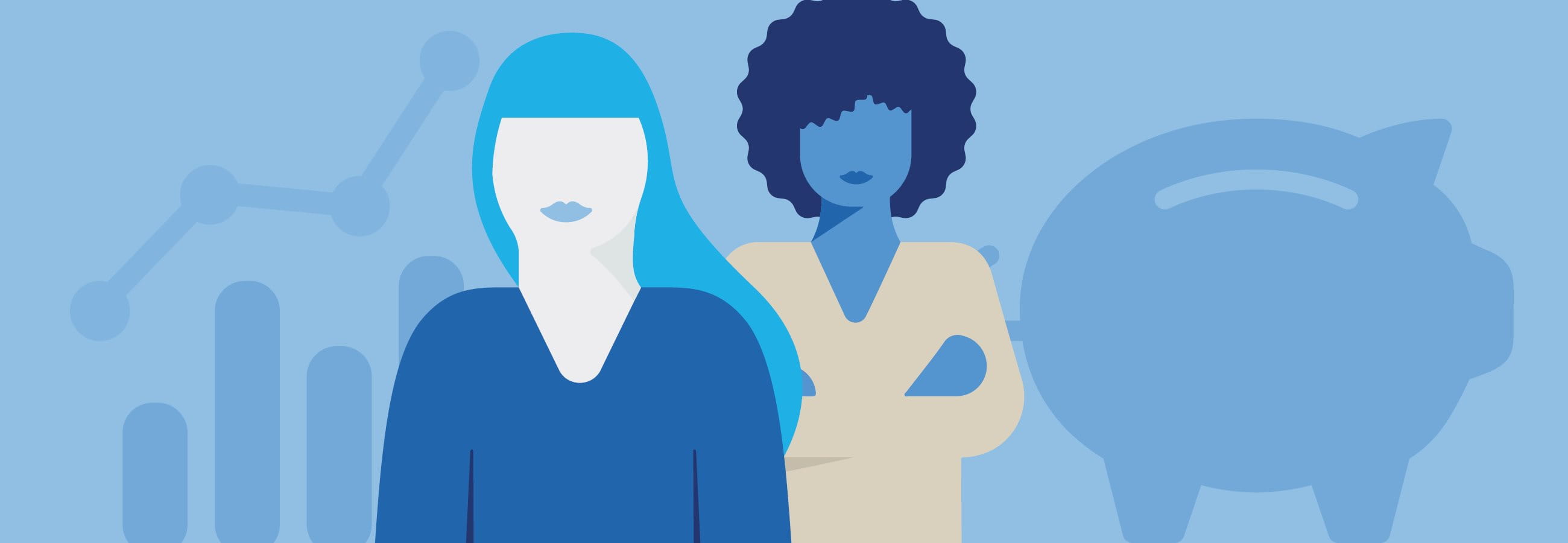"Will I have enough money to live well in old age?" This is a question that plagues many people – the "fairplay" study shows a significant gap between dreams and reality. Also on the Swiss Worry Barometer, pension gaps have long been a fixture and are among the top worries for 37% of those surveyed.
"Do I have a pension gap too?"
What is less well known is that gaps can also arise with respect to the life risks of "permanent disability/invalidity" and "death." Experience shows that most people have a pension gap with respect to at least one of the three risks, but often all three.
But how can such gaps be identified – and above all, how can they be closed? There is no one answer to this. After all, pension situations are as individual as people's life stories – each individual case is different.
Nevertheless, there are certain "risk factors" for pension gaps:
- Years with no gainful employment, for example due to raising children
- Years with a low income, for example due to part-time work
- Long periods of education or migration to Switzerland as an adult
- Running your own business
- Unexpected life events such as divorce
- Owning residential property
- Children
In the next paragraph you can find more information on the topics that are important to you. Click on these and learn in detail how the different risk factors impact your personal pension situation. You can also get tips on what you can do to improve your pension situation.
Either way, we recommend that you use our pension calculator to gain an initial overview. After that, it is worth discussing your situation with an adviser and creating an individual analysis – to enable you to fill your specific pension gaps.
Risk factors for a pension gap – learn more
I wasn't in work for a few years
The Swiss three-pillar retirement provision system assumes, as standard, that people will work in fixed employment for their entire working life and pay into the 1st and 2nd pillars each year. This means that breaks in employment often lead to pension gaps.
1st pillar
A full OASI (old-age and survivors' insurance) pension amounting to CHF 30,240 per year at present (as of 2025) is only paid out if OASI contributions have been paid for 44 years, with an average income of at least CHF 90,720. Anyone who has contribution gaps will automatically not receive the full pension from the 1st pillar. That's why it's so important to pay in the annual minimum amount even when studying, for example. This amounts to CHF 530 (as of 2025). You can also make an additional payment for missing contribution years within five years.
If you are married and your spouse is in gainful employment, you as a person not in gainful employment are exempt from your duty to contribute and will nevertheless be credited with the contribution years. Parenting and care credits are also taken into account.
- Tip: If you provide your OASI number, you can order an excerpt from your individual account (referred to as an "IK-Auszug" in German) from any cantonal social security institute and find out what OASI pension you can expect. You can also find out there whether it is possible to make additional payments for missing contribution years.
You can also order the account excerpt directly from the OASI / disability insurance information office.
Important to know: Pension claims are capped for married couples. The total of the OASI pensions of both spouses can amount to 150% of the maximum individual pension at most. That's currently (as of 2025) CHF 45,360.
2nd pillar
In the 2nd pillar, occupational retirement provision, the same is currently true: For every year in which no money is paid in, the total amount of capital saved is reduced – as is the pension and, if need be, risk benefits in the event of death or disability.
- Tip: In the pension fund statement that you receive annually and can order at any time, you will see a forecast for your retirement capital. Upon retirement, you usually have the option of withdrawing your entire capital, getting a pension paid out or combining the two options. You will also find the forecast for your BVG (occupational retirement, survivors' and disability pension) pension in your pension fund statement. The extent of your risk benefits in the event of disability and death can also be viewed there. In addition, you can find out whether there is any "purchase potential." This is the amount that you can retrospectively pay into the 2nd pillar. Seek advice to discover whether such a purchase makes sense for you – and how you can optimize it from a tax perspective.
3rd pillar
Earnings breaks can also have an impact in pillar 3a restricted pension plans. This is because you can only pay into pillar 3a if you are in work and generate earnings from gainful employment of over CHF 2,500 per year.
- Tip: For some 3a insurance solutions, Zurich offers the option of switching the insurance to a 3b solution if you stop work or become unemployed. Depending on the length of the earnings break, it is otherwise worth taking out an additional new 3b solution to provide for your old age in a tax-advantaged way.
I work part-time or in a low-income sector
The Swiss three-pillar system is set up for an average income of CHF 90,720. If you earn less than this for a considerable time – due to part-time work, for instance – this will inevitably lead to you also receiving a lower income in old age and often also being less well covered in the event of death or disability.
1st pillar
The OASI old-age pension from the 1st pillar is calculated based on the average income you earn over your entire life. For the full pension, you need to pay contributions for 44 years.
Important to know: After the retirement of the second spouse, married couples together receive 150% of the maximum OASI individual pension at most.
- Tip: If you provide your OASI number, you can order an excerpt from your individual account (referred to as an "IK-Auszug" in German) from any cantonal social security institute and find out what OASI pension you can expect or what benefits will be paid out in the event of death or disability. You can also find out there whether it is possible to make additional payments for missing contribution years.
You can also order the account excerpt directly from the OASI / disability insurance information office.
2nd pillar
Low incomes have a disproportionately large effect in the 2nd pillar: This is because contributions are not calculated based on gross income. Instead, a fixed amount of CHF 26,460 (as of 2025) is deducted, the so-called "coordination deduction." This equates to 7/8 of the maximum OASI pension. The coordination deduction is intended to prevent the pension fund levying contributions on salary portions that are already insured through the 1st pillar. However, in the case of part-time workers, the coordination deduction results in only a relatively small part of their wage being taken into account when calculating the insured BVG salary. This has an impact on benefits after retirement and, if need be, also on risk protection in the event of death or disability.
- Tip: Some pension funds reduce the coordination deduction for part-time workers according to how many hours they work – so enabling them to lower the pension gap for employees. Ask what the arrangements are at your pension fund.
3rd pillar
With annual earnings from gainful employment of CHF 2,500 or more, you can pay contributions into a pillar 3a restricted pension plan in principle. The challenge on a low income is that too little money is left over for retirement provision.
- Tip: Even if you have little financial leeway, you should try to pay at least a small amount into pillar 3a. Since you can deduct the contribution from your taxable income, you will save on part of the premium in taxes.
Depending on your nature, an insurance solution or a 3a account may be the better option for you.
Arguments in favor of an insurance solution: You can integrate various risk components, for example a premium waiver in the event of disability. In this way, you can be certain that you will actually achieve your savings goal. With an insurance solution, you conclude the pension policy with a fixed period of insurance and commit to paying in a certain amount regularly. This disciplines you, although there are opportunities to make adjustments.
Arguments in favor of a 3a account: You are completely flexible and can decide at short notice at the end of the year how much money you have left for retirement provision.
As a part-time worker, you will probably also have gaps when it comes to covering the life risks of death and disability. You can fill these via pillar 3a or pillar 3b (unrestricted pension plan). There are arguments for both options. The most important thing is making sure you are actually covered in the first place.
I was in education for a long time or only came to Switzerland as an adult
If you only start paying contributions into Switzerland's three-pillar system after the age of 21, pension gaps inevitably arise. The later you start making contributions, the larger the gaps will be.
1st pillar
Students are obliged to pay a minimum amount of CHF 530 into OASI from their 20th birthday. From their 25th birthday, a contribution must be paid in accordance with social circumstances.
The OASI contribution payment is certainly to be recommended to ensure that the OASI pension is not subsequently reduced due to missing contribution years.
Anyone migrating to Switzerland in the course of their adult life cannot compensate for the missing OASI contribution years and must satisfy themselves with a lower OASI pension (some 2.3% per missing contribution year).
- Tip: Take your OASI contribution obligation seriously and make additional payments for missing contribution years in the event of temporary residence abroad.
If you have immigrated to Switzerland, if you provide your OASI number, you can order an excerpt from your individual account (referred to as an "IK-Auszug" in German) from any cantonal social security institute and find out what OASI pension you can expect or what benefits will be paid out in the event of death or disability. You can also find out there whether it is possible to make additional payments for missing contribution years.
You can also order the account excerpt directly from the OASI / disability insurance information office.
If you worked in your homeland, you also have pension claims with respect to this employment. These can likewise be queried by contacting the relevant state departments. If you remain in Switzerland even after OASI retirement, you may need to apply for the relevant pension specifically in your country of origin. Find out early so that you can take account of this pension component in your planning.
2nd pillar
By law, retirement savings are accumulated in occupational retirement provision from the age of 24. If you don't enter professional life until later or come from abroad, gaps will arise in your occupational retirement provision. Depending on how your pension plan is set up, you will have the opportunity to pay in missing capital at a later date – in other words, to make a pension fund purchase.
- Tip: In the pension fund statement that you receive each year from your employer, you can find out whether any "purchase potential" exists. This is the amount that you could pay into the 2nd pillar retrospectively to improve your retirement provision and, if need be, your pension fund benefits for the risks of death and disability. Seek advice to discover whether such a purchase makes sense for you – and how you can optimize it from a tax perspective.
3rd pillar
If you can expect gaps in the 1st and 2nd pillars, it is all the more important for you to pay into the 3rd pillar consistently and as extensively as possible.
In pillar 3a (restricted pension plan), as a gainfully employed person with a pension fund you can pay in a maximum of CHF 7,258 per year (as of 2025). This amount can be deducted in full from your taxable income. However, the money is blocked until five years before your retirement and can only be withdrawn earlier in exceptional cases, e.g. if you take up self-employment, to finance residential property for your own use or if you leave Switzerland for good. If you are married and you both work, the 3a contributions of both spouses can be deducted from taxable income.
The 3rd pillar also offers you the opportunity to close any possible gaps with respect to risks (death and disability), which may have arisen for reasons including delayed entry into the Swiss pension system.
- Tip: Don't just make use of a pillar 3a restricted pension plan; take advantage of a pillar 3b unrestricted pension plan as well and improve your pension situation flexibly. If specific conditions are met, the sum paid out under pillar 3b is tax-free. You can also take out term life insurance as cover against the risks of death and disability in both pillar 3a and pillar 3b.
I am or have been self-employed
As a self-employed person, the risk of pension gaps is particularly high. This is because, as an entrepreneur, you may sometimes earn more and sometimes less depending on how business is going. In particular, you will probably not know at the start of the year how much you will earn in the course of the year. This makes it all the more important to pay particular attention to the subject of retirement provision.
1st pillar
As a self-employed person, you are obliged to pay OASI contributions from January 1 after your 17th birthday. You will also need to pay these contributions for your employees. Self-employed individuals also pay the employer contribution themselves – unless, for instance, they are employed at their own company in the context of a limited corporation. From an annual income of CHF 60,500, the premium rate for self-employed people for OASI, disability insurance and the loss of earnings compensation scheme amounts to a total of 10% of the income subject to contributions: 8.1 percent for OASI, 1.4% for disability insurance and 0.5% for the loss of earnings compensation scheme (for military service or maternity leave). Self-employed individuals do not pay any contributions to unemployment insurance and so are not insured against unemployment.
The OASI old-age pension from the 1st pillar is calculated based on the average income you earn over your entire life. For the full pension, you have to pay contributions for 44 years and have had an annual income of at least CHF 90,720 on average.
Important to know: After the retirement of the second spouse, married couples together receive 150% of the maximum OASI individual pension at most.
- Tip: Budget for OASI contributions monthly to ensure there is no rude awakening when one of the quarterly payment-on-account payments is due or the final amount is billed.
Incidentally, if you provide your OASI number, you can order an excerpt from your individual account (referred to as an "IK-Auszug" in German) from any cantonal social security institute and find out what OASI pension you can expect or what benefits will be paid out in the event of death or disability. You can also find out there whether it is possible to make additional payments for missing contribution years.
You can also order the account excerpt directly from the OASI / disability insurance information office.
2nd pillar
Occupational retirement provision in accordance with the BVG is not mandatory for self-employed people. Anyone who wants to can join a pension fund voluntarily. The same applies for accident insurance (LAI).
If you have a pension fund, the same rules apply to you in principle as to employed persons. However, you have the opportunity to align your pension fund with your personal requirements and to include extra-mandatory benefits, both with respect to retirement provision and risk benefits.
- Tip: Seek detailed advice on the topic of pension funds to ensure you find a solution that is tailored precisely to your needs. Don't just consider investment strategy, interest to date and the cost structure, but also consider risk benefits in the event of death and disability. In addition, clarify how flexible the solution in question is. For instance, are there solutions for partial retirement, early retirement or late retirement?
3rd pillar
If you don't have a pension fund, as a self-employed person you can pay up to 20% of your net income, but at most CHF 36,288 (as of 2025), into pillar 3a. In this case, the 3rd pillar becomes the mainstay of your income in old age, as otherwise you can only count on the basic benefits from OASI. This makes it all the more important for you to find the optimal solution for you.
For self-employed people with a pension fund, the same rules apply in principle as for employed persons – an amount of up to CHF 7,258 can be paid into pillar 3a annually (as of 2025).
For self-employed individuals too: The money from pillar 3a is blocked until five years before retirement and can only be withdrawn earlier in exceptional cases, e.g. to finance residential property for your own use or if you leave Switzerland for good.
- Tip: As an entrepreneur you already bear many risks. Spread your risk in the 3rd pillar and distribute your money across different providers. From a tax perspective, having the amounts paid out in a staggered manner may make sense. Seek advice in this respect.
I am getting divorced or am already divorced
Unexpected life events such as divorce also have an impact on your pension situation – and often in all three pillars.
1st pillar
Divorce has a particular impact on your retirement provision from the 1st pillar if you yourself are not gainfully employed. This is because you were covered alongside your gainfully employed spouse during marriage, but this protection no longer exists after divorce and you will have to pay your own OASI contributions.
When you reach OASI age, the OASI contributions of the spouses for the duration of the marriage are automatically split.
2nd pillar
In the event of divorce, both spouses essentially – depending on the matrimonial property regime – have the right to half of the amounts that were paid in during the marriage and until divorce was filed for. Whether this leads to an improvement in, or the worsening of, your pension situation depends on which of you earned more and how good the respective pension fund is. Important: Vested benefits from former jobs also have to be taken into account, provided that they were acquired during the marriage.
3rd pillar
If the separation of property was not provided for, the credit from pillar 3a and pillar 3b that was saved up during the marriage also has to be divided up in the event of divorce. However, the funds from pillar 3a are not usually paid out until retirement.
- Tip: Seek comprehensive advice on the impact your divorce has on your personal pension situation – and what options you have now.
I own residential property
As a residential property owner in Switzerland, you are highly likely not to have paid off the money owing on your house but to have a mortgage for several hundred thousand Swiss francs. While you don't have to pay rent every month, you have the fixed costs for your mortgage.
Ideally, before acquiring residential property you should have checked your pension situation and closed possible gaps, particularly with respect to the risks of disability and death.
1st pillar
You receive benefits after retirement or, if need be, in the event of permanent disability (invalidity) from the 1st pillar. Your spouse and any children you have who are still minors or who are in education would likewise receive money in the event of your death. But would these benefits be sufficient to enable you to retain your real estate? This question should be clarified at an early stage.
Early on, you should ask yourself whether your real estate is still affordable after retirement, whether you could still afford it in the event of disability and whether your family could continue to finance the house in the event of your death.
- Tip: If you provide your OASI number, you can order an excerpt from your individual account (referred to as an "IK-Auszug" in German) from any cantonal social security institute and find out what OASI pension you can expect or what benefits will be paid out in the event of death or disability.
You can also order the account excerpt directly from the OASI / disability insurance information office.
2nd pillar
You also receive benefits from the 2nd pillar in old age and in the event of death or disability. On your pension fund statement, you can find out how much money you can expect. If you have used money from your pension fund to finance your residential property, a pension gap will have arisen. This not only affects your income in old age but, if need be, your risk protection in the event of death and disability.
- Tip: There is a lot to consider in relation to the question of whether, how and when withdrawn amounts should be paid back in again through a pension fund purchase or whether amortization via the 2nd pillar may make sense. Seek comprehensive advice.
3rd pillar
You can use the 3rd pillar to fill any possible pension gaps from the 1st and 2nd pillars. This applies not only to your income in old age, but also in the event of death or disability. Pillar 3a also gives you the opportunity to indirectly amortize your mortgage. Have you used funds from the 3rd pillar to increase your equity? If so, you should try to close the pension gap that will have arisen to the greatest possible extent. Seek advice in this respect.
- Tip: Find out how large your pension gap is and seek advice in this respect: On the basis of your individual account statement (benefits from the 1st pillar) and your pension fund statement (2nd pillar), your adviser can tell you what benefits you can expect in old age or in the event of death or disability. Any benefits from the 3rd pillar are also taken into account in the analysis. You can then work out a solution together to close possible gaps in a targeted manner. Particularly in respect to imminent retirement, financial or pension planning is sensible, especially for residential property owners.
I have children who are minors
You will suspect it already: Children are expensive. And they get more expensive as they get older. As well as increased costs for accommodation, food, clothes, furniture and holidays, there are also expenses for childcare, hobbies and sports activities, as well as for education. At the same time, as parents you often have a lower income because one or both of you may have reduced the hours you work.
Due to higher expenses and a lower income, there is often little left over for saving. This makes it all the more important to check your pension situation. After all, you are not only responsible for yourself but also for the protection of your children.
1st pillar
In the event of invalidity, not only would you receive a disability pension but your children would also receive a disabled person's child's pension until they have completed their initial education (at most until 25). In the event of death, your children would likewise receive an orphan's pension. Whether your partner receives a widow's or widower's pension depends on various circumstances.
Even if you are not gainfully employed, as a parent you are granted parenting credits for old age. Likewise, as a married person not in gainful employment, you can benefit from the OASI contributions of a spouse in gainful employment.
- Tip: If you provide your OASI number, you can order an excerpt from your individual account (referred to as an "IK-Auszug" in German) from any cantonal social security institute and find out what OASI pension you can expect or what benefits will be paid out in the event of death or disability. You can also find out there whether it is possible to make additional payments for missing contribution years.
You can also order the account excerpt directly from the OASI / disability insurance information office.
2nd pillar
You also receive benefits from the 2nd pillar in old age and in the possible event of death or disability. Your children would likewise receive a disabled person's child's pension or an orphan's pension in the event of death. Your spouse or cohabiting partner would also get a widow's or widower's pension under certain circumstances.
- Tip: Clarify whether the expected benefits in the event of death or disability would be sufficient for your family or whether there is a pension gap and additional private cover may be necessary. If you have had children late, they may still be in education after you retire and may require financial help. Your pension fund statement provides an initial reference point. In a pension analysis, your adviser can show you how the two pillars work together and where you need additional protection.
Important for cohabiting partners: Make sure you are registered as the other person's partner with their pension fund and clarify what benefits you would be entitled to. Depending on the regulations, this may vary.
3rd pillar
You can use the 3rd pillar to fill any possible pension gaps from the 1st and 2nd pillars. This applies not only to your income in old age, but also in the event of death or disability. It is important that you always take the needs of your children into account when planning your retirement provision: Who would look after them if, for instance, you needed permanent care or were even to die? Would additional childcare costs arise due to this? How can you ensure that the family could continue to live in their usual surroundings even in the event of death? Seek advice in this respect.






